
AKSHARA SWAROOPAM
Let us begin this part-3 with a lovely rendering on Goddess of Akshara Vidhya.
Double click the link below; listen to Saraswathi Stothram by Saint Agasthya:
The word “Aksharam” means: “that which does not perish” and it indicates the Para-Brahman. It is the opposite of Ksharam, meaning “perishable”.
“Na Ksharathi Ithi Aksharam” - Mandukopanishad
“Tadetad Aksharam Brahma”- Upanishad Mahavakyam.
“Aksharam Aroopam” - Aksharam is formless and hence cannot be deformed.
“Akshara” in Sanskrit also means a letter in alphabet. It derives its name from the fact that the first letter of the Sanskrit alphabet is 'a' and the last is 'ksha'. Combining these two characters, one gets the term “Akshara”, which is used to denote all the letters in entire aksharamala, the String of Letters.
Human beings have many things in common with other species on earth, such as dependencay on food, sleep, fear of death and desire to propagate. However, it is our faculty of speech and thought process that distinguishes us from the rest, which follow only their instinct. This faculty is so unique that it developed the human species to higher levels of evolution and made us realize the real meaning of life, the Purushartha (Purusha means human beings, Artha means aim, object, goal etc).
It is said in the Puranas that the deities of vak (Speech), namely Vasinyadi Devatas (Vasinya and others), recited the beejaksharas for thousands of years, before they became qualified for reciting the Lalitha Sahasranama.
Devi is praised in Lalitha Sahasranama as Ksharaksaratmika (L.S.757). She is the Pronunciation formed by the combination of alphabets. She is ‘matrka-varna-rupini’. (L.S.677) She is of the form of all alphabets, words and sounds.
“amantram aksharam nasti ! Nasti mulam anaushadham!!
ayogya purusho nasti ! yojakah eva durlabhah !! “
It means: "There is no alphabet from which a mantra cannot be made. There is no herb from which a medicine cannot be made. There is no person who is incapable. Who is rare is the one who can organize"
“Jnaanaadhishthaanam Maatrkaa” - Verse 1.4 of Shiva sutra
(The Base of knowledge is Matrika, the power of sound).
Following is the observation in November 2008 by Kate Wilson of the Ohio State University in her senior honors thesis, presented in partial fulfillment of the requirements for graduation with research distinction in Comparative Studies: “Tantric Sound: The Nondual Śaivism of Kashmir’s Manifestation and Liberation in Sanskrit Words, Deities, Tattvas, and Chakras”, Project Advisor being Professor Hugh Urban Department of Comparative Studies:
Dating as far back as the RigVeda, we see the importance and sacredness of sound. The sequence of sounds and the discovery of a “very large number of phonetic symmetries in the first hymn of the RigVeda could not have been humanly conceived.
The Hindu Tantric sect, the nondual Śaivism of Kashmir, originating in the Kashmir region of India around the late 8thcentury, perceives sound as all-pervasive throughout manifested reality, as a symbol of the universe’s cosmic structure, and to a soul’s liberation.”
Sound, created in the process of speech, and formed through reciting Sanskrit words, is vital in all religious aspects within Kashmir Śaivism - in prayer, ritual and meditation. Even more specifically, the characters that make up the religious texts themselves are derived from sacred representations of deities and represent different vibrational energies in the body, and therefore when correctly recited, are vehicles to instantaneous liberation.
As per Kashmir Śaivite philosophy, the “Divine Consciousness is identical with the Supreme Word (para vak), and hence every letter or word is derived from and ultimately inseparable from this Consciousness”. The “divine consciousness” within Kashmir Śaivism’s cosmological framework is the absolute form of god, which is immanently monistic. Therefore, the analysis of language is inseparable from that of [the analysis of] consciousness.
In addition to the view of sound as consciousness, sound is also a symbol and tool of universal liberation. Liberation is recognizing the true nature of one’s own self, which is identical with the true nature of all reality and god.
Within Kashmir Śaivism this liberation through sound occurs on every level of manifestation; that is, in the realms of gods, human bodies, and written texts: therefore, connecting all reality through a universal experience of divine freedom.
I will explore how sacred sound pervades the universe on each of these levels and how it is used for the awakening of the soul. Sound is the link between the three main levels of reality - the causal (absolute God), subtle (energetic) and gross (physical) realms of the universe. Each layer of the manifest world is ordered based on the consciousness or quality of energy characterized by it. The creation of these layers, or tattvas, begins with the most absolute form of God, ParamaShiva, and successively devolutes step-by-step, all the way down to the most gross or concrete layer, the earth. The interplay between these layers is through the process of sound and speech.
I will explore how sacred sound pervades the universe on each of these levels and how it is used for the awakening of the soul. Sound is the link between the three main levels of reality - the causal (absolute God), subtle (energetic) and gross (physical) realms of the universe. Each layer of the manifest world is ordered based on the consciousness or quality of energy characterized by it. The creation of these layers, or tattvas, begins with the most absolute form of God, ParamaShiva, and successively devolutes step-by-step, all the way down to the most gross or concrete layer, the earth. The interplay between these layers is through the process of sound and speech.
Logic follows that if all is interconnected, and if the macrocosm can influence the microcosm through replication, then there must be a universal weaving in and out of the multi-leveled interconnected web of the universe. This universal weave is sound, or Śabda. Śabda as speech, mantras, vibration, and Sanskrit word themselves traverse all tattvas of existence.
Lalitha literally means “She who plays”. She is beyond “nama rupa” and does not have any name or form. We describe Her as Lalitha, based on one of Her characteristics, Her Leela. Though She is far beyond any language, Sri Lalita is also known as Matrika Devi, the Goddess of the Letters of the Sanskrit Alphabet, the Sarada Devi or the Saraswathi. This kind of personification of the Sanskrit alphabets as Matrika Devi is liberal in Tantric Literature.
Sri Yantra is inscribed all over its triangular geometric body with all the letters of the Sanskrit alphabets. Her Sri Vidhya mantra is made of the 15-letter group “Ka E I La Hrim, Ha Sa Ka Ha La Hrim, Sa Ka La and Hrim”. The vowels are Bija (Seed letters) and hence considered as Lord Shiva himself and the consonants are considered as Shakti. The letters A to Ksha, together with visarga and bindu represent Her triple form, the body of the absolute.
The Vamakeswara Tantra describes the Goddess as “Mother of Leters” in its initial Slokas. She is described therein as the thread of letters of which the whole universe is woven. She is the Siddha Mata of the 8 letter-groups “A-Ka-Cha-Ta-Ta-Pa-Ya-Sa”. She is the essence of letter “I” (EI). She is Maya of 36 Tattvas, corresponding to 36 consonenets of the Sanskrit Alphabet. She is the form of 15 Nityas (Moon Thithis) corresponding to the 15 vowels. She is of the form of Sapta Matrika Devis.
In his famous work, “Garland of Letters”, Arthur Avlon describes this connection between Devi and the Sanskrit letters. He has authored several books on Shakti worship in India and his collections are worth reading if one wants to have an over view of Shaktham.
Shakti is worshiped in several forms or swaroopams, such as Saguna swaroopam (having all Gunas), Nirguna swaroopam (having no guna), Sukshma swaroopam (no form), mantra swaroopam (in the form of Mantra), Yantra Swaroopam (of the form of Sri Chakram), and Tantra Swaroopam (of the Kundalini form). In addition, She assumes the Akshara swaroopam (of the form of Sound), thus making the Sanskrit alphabets divine.
Omkara swaroopam (Sabdha Prapancham or Sonic form) has been the unique principle of Hinduism, which believes that the entire Universe came out of the initial sonic vibration called "Spandana" and that this initial intention to vibrate developed in stages from “Para sound” (subtle sound which is not audible to human beings) to “Pashyanti” (becoming audible) and then became “Madhyama” (midway between subtle sound and human voice) and finally it became “Vaikhari” (sound produced by human effort). This voice generated can be distinguished as “Dhvani” (mere noise) and “Varna” (recognizable good sound). Creation is said to have further crystallised or condensed into gross form of Artha Prapancham (five elements of Akash, Air, Fire, water and Earth) gradually from the subtle sound or Subda Prapancham through various stages called Tattvas.
This Varna or the meaningful sound can be further classified into five different forms of human sound, based on the position in human sound-track from which emanates. These sounds are called (1) Gutterals (tongue touching interior soft palate), (2) Palatal (tongue touching the back of the hard palate), (3) Cerebral (tongue touching the top of the hard palate), (4) Dental (tongue touching the top front teeth) and (5) Labial (lip movements without the aid of the tongue).
It is interesting to note that there are only two classifications, namely, “sonic” and “ultra-sonic”, by those scientists dealing with the Physics of sound. One cannot but wonder at the detailed classification of sound by Indian Sages, so minutely from “Para” sound, which cannot be heard, right down to “Varnas” in the form of 51 alphabets. The Divine Sound thus became the human voice, rightly called “Devanagari” and was distinguished into various Varnas of 51 sound letters of the Sanskrit language, each one having a unique identity called seed sounds (Bija mantras). From these sounds of the 51 letters, the entire group of mantras emanated and following therefrom, the Vedas emanated. Hence Devi, who is of the form of Aksharas or Matrikas, is known as "Vedamata" or “Matrika-varna-roopini”. She is the Mother of the sound principle. She is called Pranava-swaroopini.
Each of the 51 letters of the Sanskrit alphabet has its own devata or god associated with it and is also ascribed a specific colour as well as scent to represent it. The vowels numbering 15 and the consonants numbering 36, aggregating to 51, also have very close relationship with space and time (Kaala). The 15 vowels represent the 15 Nitya Devis (thithi of the moon), while the consonants represent the 36 Tattvas through which Shakti creates the Universe from subtle sound. She is “Panchaashad Peeta Roopini”.
“Kamadhenu Tantra”, a text of the conversation between Shiva and Parvati Devi, explains the importance of Sanskrit letters or Matrikas. In all its 24 chapters, it vividly explains the significance of each letter and the benefit of reciting and meditating on these letters, as young and adolescent Matrika Devi, in the form of Saraswathi, dressed in pure white. It says that the letters “A” to “Ksha”, combined with the visarga or bindhu, forms the very body of Devi, from which all veda, smriti and mantras emanated.
By reciting the fifty letters of the alphabet with the out and in breaths, 12 times at the three twilights (sandhya), one does jiva nyasa. This tantra goes on to describe a correlation between the letters of the alphabet and the tattvas, then correlating different letters with the five elements aether, air, fire, earth and water.
The letters are then related to 50 forms of Devi, as young maidens. The book describes the effects of pronouncing each of the Matrikas separately. It's said that the letter ka is the root of all the varnas, and so a person should worship this letter with every effort. Success in worshipping ka and Kamini causes one to realise the essence of the Kamadhenu.
What are "Maha-Vaakyams"
Time ripens and dissolves all beings in the great self; but he who knows into what time itself dissolves is the knower of the veda.- Maitrayana Brahmana Upanishad
Tattvam or the great philosophy is found in the Mahavakyam (greatest statements) mentioned in the Vedas
1. “Pragnyanam Brahman”- Consciousness is God. (Aitareya Upanishad 3.3 of the Rig Veda)
2. “Aham Brahmasmi” - I am God. (Brhadaranyaka Upanishad 1.4.10 of the Yajur Veda)
3. "Tat tvam asi" - "You are That God”. (Chandogya Upanishad 6.8.7 of the Sama Veda)
4. “Ayam Atma Brahma”- Self is God. (Mandukya Upanishad 1.2 of the Atharva Veda)
5. “tat satyam sa Aatmaa tattvamasi”- That Aatmaa is the truth.You are that Aatmaa (Chandogya Upanishad – 6-9-4)
6. “Jagat Kaaranam Brahma” – Brahman is the cause of the Universe.
Further declarations of these kind are found abundant in Srutis, Smritis and Agamas, such as:
b) "lsa vasyam idam sarvam" - All in this universe is lsvara,
c) "Atmaiva idam sarvam" - All is indeed Atman.
d) ”Sarvam kalvidam Brahma"- All in this universe is Brahman,
e) “Atmanyeva Atmaanaam Pashyeth” – Seek Atman within yourself
Tattvam indirectly indicates that all beings on this Universe have come out of God and in that sense, nothing is different from God. It is believed that Shakti separated from Brahman to create this Universe.
Tattvams are the building blocks through which Prakruti creates the Universe, in union with Purusha. She is the Moola Prakriti or the root cause of all that is Universe today.
(The Will of Shakti creates Body)
As per Hindu belief, creation and destruction keep happening in continuous mode. After pralaya or destructive phase, the Prakruti is in a state of equilibrium with Her three Gunaas, namely, Sattva, Rajas and Tamas, and goes into deep sleep mode. Sattva is passiveness; rajas is full of activity and Tamas corresponds to darkness or ignorance. When this equilibrium is disturbed, creation begins to manifest in different ratios of the three Gunaas.
Following is the list of all the 36 Tatvas, starting from Shakti separating from Shiva, in the beginning, and then Shakti slowly creating the Maya and then the subtle energy becoming denser and denser to condense into Pancha boothas (Akash, Air, Fire, Water and Earth) and finally culminate into gross matter. These are therefore the building blocks of our material world.
1. Shiva Tatva
2. Shakti Tatva
3. Sadashiva Tatva
4. Isvara Tatva
5. Suddhavidya Tatva
6. Maya Tatva
7. Kala Tatva
8. Asuddha Vidhya Tatva
9. Raga Tatva
10. Niyati Tatva
11. Kaala Tatva (Time)
12. Purusha Tatva
13. Prakrithi Tatva
14. Buddhi Tattoo
15. Manas Tatva
16. Ahamkara – ego
17. Sravanendreya (Hearing)
18. Supershanendreya (Feeling by touch)
19. Darshanendreya (Seeing)
20. Resanendreya (Taste)
21. Ghranendreya (Smell)
22. Vagendreya (Voice or expression)
23. Hastendreya (Handling)
24. Padendreya (Locomotion)
25. Payvendreya (Rejecting, Discharging, excreting)
26. Upasthendreya (Resting or recreating, procreating)
27. Shabdatanmra (sound)
28. Sparshatanmra (Feel)
29. Rupatanmra (Color)
30. Rasatanmra (Flavor)
31. Ghandhatanmra (Odour)
32. Akasha (ether)
33. Vayu (Air)
34. Agni (Fire)
35. Apas (Water)
36. Pritvi (Earth)
The Power of Alphabets
"There must be, besides other forms of devotion, faith. The seeker must have faith — a faith as natural as breath (svas to breathe) — in the sacred character of the Mantra as the sound-body of the Deity invoked, in the Mantra as a chosen channel of the Grace o f the Guru. When both, tradition and faith, conjoin the Mantra, there is no fulfilment that is denied to the disciple. Faith is a witness to a truth not yet experienced; it is an advance intimation of the knowledge still to be acquired.- PARASURAMA KALPA SUKTHAM.
Another important connection, between the Sanskrit alphabets and Devi worship is in the use of these alphabets in the mantras of Devi. These Akshara sounds form different combinations and become Mantras.
In this fashion, Vedas emerged from out of the “Pranava” sound, which in turn is a combination of three letters, A, U and M. Put differently, this “AUM” becomes “UMA”, the Goddess. Thus, these letters lend their might to form powerful words and represent the Devi Herself.
The Sapta-Matrukas, (seven goddesses) who are presiding Deities of the group of Consonants as explained earlier, together with the Divinity for the Vowels known as “Vasiya” form the important set of eight Matruka Devis, known as “Vak Devatas”. Since this set of Devis is led by Vasinya Devi, they are also known as “Vasinyadi Devatas”. These are the Devatas who recited Lalitha Sahasranamam as desired by Goddess Lalitha. Just as the 15 Nitya Devis, who reside in the first triangle of the Sri Chakra, these Eight Devatas also got their importance recognised and reside close to the Devi in the Seventh Avarana of the Sri Chakra.
Mantras are like seeds which contain the whole of creations hidden in it. Mantras are the seeds kept hidden in the soil, which when watered regularly, sprouts to become fruit bearing trees. The power of Mantras is such that, not only those who recite the Mantras, but also those who hear it or even mentally recite while reading them, get fully blessed by these Vasinyadhi Devatas, who are the Mothers of Sounds. For that matter, even the Avarana in the Sri Chakra, occupied by these eight Devatas, is known as “Sarva-roga-hara-chakram”. Reference may be made to Lalitha Sahasranamam 88th nama describing Devi as - “Moolamanthrathmika” and 89th nama – “Moolakoota triyakalevara”.
The 15 Nitya Devis rule the 15-lettered mantra known as Panchadasakshari or Sri Vidhya or Mula Mantra.
“Ka E Ai La Hreem- Ha Sa Ka Ha La - Hreem Sa Ka La Hreem “.
Lalitha Trisathi, which contains 300 holy names of Devi, explains the importance of this mantra. We can find that these 15 letters, beginning with “Ka”, form the first letter of the various stanzas of the Trisathi as given below: –
Kakara Roopa Kalyani Kalyana Guna Shalini
Eakara Roopa Eakaksharya Eka Aneka Akshra Krithi
Eekara Roopa Eesithri Eepsithartha-pradayini
Lakara Roopa Lalitha Lakshmi Vani NiShevitha
Hreemgara Roopa Hreemgara Nilaya Hreem Pada Priya
Hakara Roopa Hala Drith Poojitha Harinekshana
Sakara Roopa Sar Vagna Sarvesi Sarva Mangala
Kakara Artha Kala Hanthri Kameshi Kamithartha Da
Hakarartha Hamsa Gathi Haataka Abharnojjwala
Lakarakhya Latha Poojya Laya Sthith Udbaveswari
Hreemgarini Hrinkaradhi Hrim Madhya Hrim Shikhamani
Sakarakhya Samarasa Sakalagama Samsthitha
Kakarini Kavya Lola Kameshwara Manohara
Lakarini Labdha Roopa Labhdha Di Labhdha Vanchitha
Hreemkara Moorthi Hrim Kara Soudha Shringa Kaphodhiga
The first five letters from “Ka” to “Hreem” are collectively known as “Vak Beejam” representing Devi’s face. “AIM” is the Mantra for this Beejam. Sri Lalitha Sahasranamam refers this as “Srimat Vakbhava Kootaika Swaroopa Muka Pankaja”.
The second set of Six letters from “Ha” to “Hreem” are known as “Kama Beejam”, representing Devi’s Neck to Waist. “Kleem” is the Mantra for this Beejam. “Kanthaadhah katiparyantha madhya koota swaroopini”, as described in Lalitha Sahasranamam.
The last four letters are known as Shakti Bijam. “Sou” is the Mantra for this Beejam. “Shakti kootaika tapanna katyatho bhagatharini” – L.S.
Sri Muthuswami Dheekshidar, explains these Panchadasakshari mantra in his Krithi in madhyamavathi called “Dharmasamvardhani”
Click the following link and enjoy the musical video on “Dharmasamvardhini”.
Sloka 32 of Soundarya Lahari describes the “Panchadasa varna roopam” of Ambal.
“Shivah Shaktih kamah kshitir atha ravih sithakiranah
Smaro hamsah sakrastadanu cha para-mara-harayah;
Amee hrllekhabhis tisrbhir avasanesu ghatitha
Bhajante varnaste tava janani nam'avayavatham”.
The letter ‘ka’ refers to Shiva, ‘a’ to Shakti, ‘ee’ to Manmatha, ‘la’ to earth, ‘ha’ to Sun, ‘sa’ to Moon, etc and the letter Hrim links the three parts of the body of this 15-letter mantra. The three Mantras, “AIM, Kleem and Sou” are known as Triyakshari or Laghu Vidhya and are often used in place of the 15 Panchadasakshari.
By adding “Shreem” to Panchadasakshari of 15 Letters, it becomes “Sodasakshari” (16 Letters). It forms the 587th Nama of Devi in the Lalitha Sahasranamam as “AtmavidyA mahAvidA srividyA kAmasevita Sri SodasAksharI vidyA”. This Shodasakshari vidhya is said to be the most revered and most secretive (Rahasya) of all the mantras. Parasurama’s Kalpa Sutra explains this path of Srividhya further.
The words constituted of letters are eternal. The Mantras are not constructed by the humans and subject to dissolution as all human constructions are . They are formed out of the eternal Speech, the expressive stress of the Primordial Consciousness, and hence carry its supernal potency. - "PARASURAMA KALPA SUTRAM".
Shodasakshari mantra is said to contain the mantras of all other deities, including that of the Dasamahavidhya Shaktis.
Sri Vidhya Kootams are situated in few holy places in Tamil Nadu, as follows:
Vakbhava Kooteswari - Kanchi Kamakshi.
Madhya Kooteswari - Madurai Meenakshi, and
Shakti Kooteswari - Thiru Aanaikka- Akiladneswari.
We will see in further readings that Yoga Sastra and Tantra Sastra also confirm, the letters La, Ha, Ya, Va, Kleem, Aim, Hreem etc have their place in our body chakras and by constant utterance of such group of letters, one can raise the Kundalini.
The “AIM” of Vakbhavakootam is like “AUM”, the Pranava Mantra. “AIM” is also known as “Chaturveda Sanketha Saram” or the essence of the four vedas. This is because, the four Vedas start with the letters as explained below:
Rig Veda – starts with “Agnimeele”. First letter is “A”
Yajur Veda starts with “Eshethva”. First Letter is “E”.
Sama Veda starts with “Agna Ayahee”. First letter is “A” and
Atharva Veda Starts with “M”, Anuswaram.
The second and third letters, “E and A”, upon grammatical combination becomes “I”. Thus, the first letters of the four Vedas give out the word “AIM” and hence “AIM” is considered as the essence of the four vedas.
Poet Kalidass, is said to have pronounced the “AI” mantra several times in his previous birth, though ignorantly, as he was a shepard and cried “AI, AI” to drive his sheep. Because of this power, it is said that Devi blessed him in his next birth, when he was born as a dumb and was turned into a Mahakavi by Kali.
Panchadasakshari Mantra, is so dear to Devi that it is known as “Shakti Pranava” as different from Vedic Pranava, the great “AUM”. While “AUM’ is the masculine unmanifest sound, cannot be heard, “AIM” is the feminine manifest form of Adya Shakti, can be heard, the cosmic feminine principle. Devi is thus Mantraroopini. Mantram is Her “Sound–Body”. She is Sabda Brahman.
“Cittham mantrah” – Shiva Suktham - 2.1
By constant chanting of Shakti mantras, the mind gets purified at deeper levels and becomes the residing place of Goddess. Mantras also have the power to cure the body of imbalances causing various disorders, if recited properly. Mention must be made here about the “Hamsa Gayatri mantra”, which is the concentrate of SRI VIDHYA:
“Hamsa Hamsaaya Vidhmahe, paramhamsaya Deemahi,
Thanno Hamsa Prachothyadh”
The bird Hamsa, like the Lotus leaf, always stays and lives in water, but never gets wet. Likewise, the wisemen lead a normal life, unaffected by their surroundings.
These men are called “Paramhamsas”, or the great Hamsa. Swami Ramakrishna Paramhamsa is a standing example of a Devi upasaka (Kaali) who stood out distinctly through deep penace. His disciple, Swami Vivekananda also experienced such bliss at the behest of his guru.
Thirumoolar, the devine Tamil poet, considered an incarnation of Lord Shiva, has mentioned in one of his quadruplets that the fifty letters of the Sanskrit alphabets are the Vedas as well as the vedaagamaas:
ஐம்பது எழுத்தே அனைத்து ஆகமங்களும்
ஐம்பது எழுத்தின் அடைவை அறிந்தபின்
ஐம்பது எழுத்தே அஞ்செழுத்தாமே-----திருமந்திரம்
Thiruvalluvar, the Tamil Saint, subtly brings it out in his very first couplet that alphabets are the primordial God himself, indirectly confirming the the creation started with Sound.
பகவன் முதற்றே உலகு.
The Bahvruchopanishad also contributes to this view as follows:
“Ruso aksharo parame vyoman
Yasmin deva athi visve nishedu”
ज्ञानाधिष्ठानं मातृका (jñānādhiṣṭhānam mātṛkā)
(The hidden power of Sound, inherent in the alphabet, is the basis of knowledge)
“You must not go wrong either in the enunciation or intonation of a mantra. If you do, not only will you not gain the expected benefits from it, the result might well be contrary to what is intended. So, the mantras must be chanted with the utmost care”. – Kanchi Seer.
Reference is invited here of an interesting article in the website: https://thapas.wordpress.com. Here, Dr. Yagnasubramanian says, “The Vedas are called ‘Sruti”- which means, what is heard. It is never read from a text, since the recitation of any veda mantra should conform to the following six parameters, namely,
varna (letters);
svara (intonation);
matra (duration of articulation)
balam (force of articulation);
sama (uniformity), and
santana (continuity).
If any of these parameters is not maintained, it would change the meaning of the mantra itself, leading to even diametrically opposite effects! In the absence of a written text, our rishis had devised many ways to prevent even a small error to creep in to the recitation of the veda-mantras. These fool-proof methods used to chant each veda-mantra in various patterns and combinations known as: vaakya, pada, krama, jata, mala, Sikha, rekha, dvaja, danda, ratha, and Ghana.
These methods of complicated recitations in an oral tradition were devised to preserve the purity of the word, the sound, intonation, pronunciation, accent and sound combinations of the vedamantras. By repeating the words in manifold ways, the correct tally of words was also kept which has naturally ensured its purity”
Those interested in hearing a rig veda mantra recital for peace and prosperity, please click the following link, close your eyes and feel the divine flow.
If you are looking for translation....
भाग्य सूक्त (Bhagya Sukta)
ऊँ प्रातरग्निं प्रातरिन्द्रं हवामहे प्रातर्मित्रा वरुणा प्रातरश्विना ।
प्रातर्भगं पूषणं ब्रह्मणस्पतिं प्रातस्सोममुत रुद्रँ हुवेम ॥1॥
Aum praataragniṃ praatarindraṃ havaamahe praatarmitraa varuṇaa praatarashvinaa |
praatarbhagaṃ pooṣhaṇaṃ brahmaṇaspatiṃ praatass somamuta rudraṃ huvem ||1||
1. At dawn, we invoke Agni (the fire deity), Indra (the rain deity), Mitrā (the Sun) and Varuṇa (the deity of the ocean); the Aśvins (the celestial physician twins), Bhaga (the deity of wealth), Puṣan (the Sun as the deity of nutrition), Bṛahmaṇaspati (the preceptor of the gods), Soma (the Moon), and Rudra (the god of dissolution)
प्रातर्जितं भगमुग्रँ हुवेम वयं पुत्रमदितेर्यो विधर्ता । आद्ध्रश्चिद्यं मन्यमानस्तुरश्चिद्राजा चिद्यंभगं भक्षीत्याह॥2॥
Praatarjitaṃ bhagmugraṃ huvem vayaṃ putramaditeryo vidhartaa |
aadhrash chidyaṃ manya maanastu rashchidraajaa chid yaṃ bhagaṃ bhakṣhityaaha ||2||
2. We invoke at dawn, the fierce Bhaga, the son (manifestation) of Aditi (the Cosmic Power), who is the very sustainer of the creation. Whether a pauper, a busy person, or a king; everyone worships and contemplates upon Bhaga saying, 'I would worship Bhaga.'
भग प्रणेतर्भगसत्यराधो भगेमां धियमुदवददन्नः। भगप्रणो जनय गोभि-रश्वैर्भगप्रनृभि-र्नृवन्तस्स्याम ॥3॥
bhagha praṇetarbhaga satyaraadho bhaghemaaṃ dhiyamudava dadannaḥ |
bhaga praṇo janaya gobhirashvairbhaga pranṛibhirnṛivantassyaam ||3||
3. O Bhaga! The great leader, and truth is your wealth. Bestow it upon us, and elevate our intellect and protect it. Bless us with cattle-wealth, horses, and descendants and followers.
उतेदानीं भगवन्तस्यामोत प्रपित्व उत मध्ये अह्नाम्। उतोदिता मघवन् सूर्यस्य वयं देवानाँ सुमतौ स्याम ॥4॥
utedaaneeṃ bhagavantasyaamot prapitv ut madhye ahnaam |
utoditaa maghavan sooryasya vayaṃ devaanaaṃ sumatau syaam ||4||
4. May we be blessed by Bhaga now (during this fire-ritual), and when the light approaches, or at midday. O Lord Indra! At sunset also, may we still find favor of the Sun, and other gods.
भग एव भगवाँअस्तु देवास्तेन वयं भगवन्तस्स्याम। तं त्वा भग सर्व इज्जोहवीमि सनो भग पुर एता भवेह॥5॥
bhaga eva bhagavaanastu devaastena vayaṃ bhagvantasyaam |
taṃ tvaa bhaga sarva ijjohaveemi sano bhaga pur etaa bhaveha ||5||
5. May Bhaga, (and) the gods be the possessor of good fortune, and through Him, may we be blessed with good fortune by that god. Everyone including myself invite you to bring in good fortune. O Bhaga! Kindly lead us being present in the ritual.
समध्वरायोषसोऽनमन्त दधिक्रावेव शुचये पदाय। अर्वाचीनं वसुविदं भगन्नो रथमिवाश्वावाजिन आवहन्तु॥6॥
samadhvaraayoshaso namanta dadhikraaveva shuchaye padaaya |
arvaacheenaṃ vasuvidaṃ bhaganno rathamivaaśhvaa vaajina aavahantu ||6||
6. May the presiding deities of the early morning-hour arrive here, like the horse that puts its foot in the place of Vedic ritual for establishing the fire altar. May they bring Bhaga, the Lord of wealth, as speedily as swift horses pulling a chariot
अश्वावतीर्गोमतीर्नउषासो वीरवतीस्सदमुच्छन्तु भद्राः।
घृतं दुहाना विश्वतः प्रपीनायूयं पात स्वस्तिभिस्सदा नः॥7॥
ashhvaavateergomateerna uṣhaaso veeravateess sadamuchchantu bhadraḥ |
ghṛitaṃ duhanaa vishvataḥ prapeenaa yūyaṃ paata swastibhissadaa naha||7||
7. May the presiding deities of the Dawn bless us with many horses and cattle, and plenty of milk and milk-products. May these auspicious gods bless us with good progeny, and nourish all life. May they proclaim auspiciousness in the place of worship. May they always ensure our good fortune
Further link on another vedic mantra recital:
I fail to believe that the ancient society was bronze age. They were far far more sophisticated and advanced than the contemporary modern society. We are nowhere near the levels of knowledge that the ancient Indian societies possessed.
Seven Forms of Devi
Saptha Matrika Devi(s)
It would be appropriate here to say a few words on Sapta Matruka Devis, i.e. the seven forms of the Devine Mother, which is widely worshipped. As per Devi Mahatmiyam, these seven Deities were created by their respective male Gods to assist Devi in fighting the demons, Sumbha and Nisumbha. These demons represent the evil qualities in us.
The first Matruka is Brahmi created by Lord Brahma. She has swan as Her vahana (vehicle), same as Brahma. She presides over the “Kha” vargha Ka, Kha, Ga, Gha, Na. She destroys Kama or Desire.
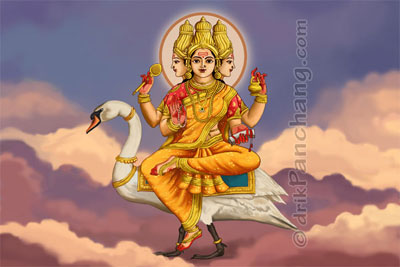
The second in the series is Maheswari (or Shivaduti) created by Lord Shiva (Maheswara). She has the third eye and uses Bull as her vahana, same as Lord Shiva. She carries a Trisula as Her weapon. She presides over the “Cha”, vargha, Ca, Cha, Ja, Jha, ….. She destroys Krodha or anger.


The third one is Kaumari, created by Lord Karthikeya. She rides on the Peacock and uses Spear as Her weapon. She presides over “Ta” vargha, Ta, Tha, Da, dha, Nna. She destroys Lobha or longings to enjoy youthfulness.
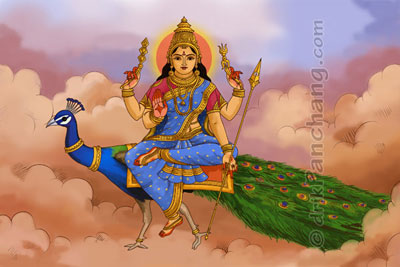
The fourth is Vaishnavi, created by Lord Vishnu. She rides on Garuda and holds Conch, Chakra, Gadha, all used by Lord Vishnu. She presides over “Tha” vargha, Tha …………. She destroys Moha, delution.

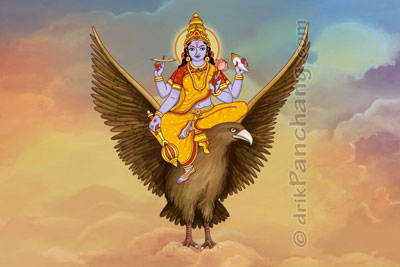
The fifth is Varahi created by Lord Vishnu and presides over “Pa” vargha, Pa, Pha, Ba, Bha, Ma. She destroys Mada or arrogance.
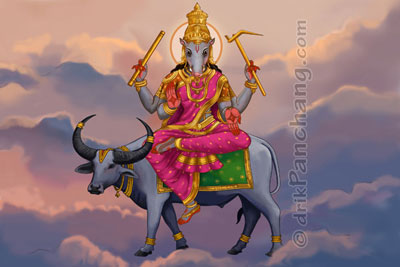
The sixth one, Indrani is of the form of Indra, the rain god and holds the thunderbolt as Her weapon. She presides over Ya, Ra, La, Va. She destroys matsarya or envy.
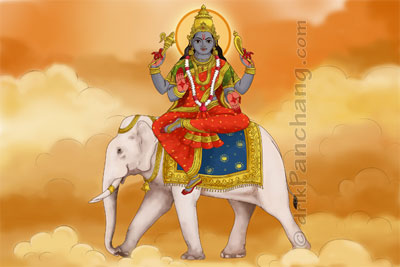
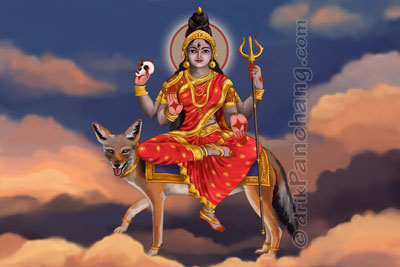
Nithya Devis.
Moon is said to control our mind, while the Sun controls our soul. While Moon represents Shakti, Sun represents Shiva. Sun and Moon unite once a fortnight, during the new moon and full moon days. During these two days of cosmic union, Shakti worship assumes special significance, especially in Sri Vidhya Pooja. More so during the full moon days since She is in full brightness and glory and readily blesses Her devotees. This aspect forms important part of tantric rituals. The waxing and waning of the moon affects our emotions. One or two days prior to this Full moon or Amavasya day is celebrated a Pradhosha Kaalam, when both Shiva and Parvathi come together to bless us all.
Indian Astrology gives importance to the phases (Thithis) of the moon and each Thithi is associated with corresponding Chandrakala which are ruled by respective Nitya Devis. There are the 15 Chandra Kalas and 15 Nitya Devis corresponding to the 15 Thithis (days) in moon’s waxing and waning phases.
The shape of the moon differs each day as it grows or reduces during the phase. Each of the 15 shapes of the moon has a different name known as Chandra-Kala. The names are as given below, just for those interested:
Manadha, Poosha, Tushthi, Pushti, Rathi, Dhruthi, Sasichini, Chandrika, Kantha, Jyostna, Shri, Preethi, Angadha, Poorna, Poorna- amrutha.
The names of the Nitya Devis who rule the ChakraKalas are: Kameshwari, Bagamalini, NityaKlinna, Bherunda, Vahnivasini, Vajreshwari, Shivadhoothi, Thvarithaa, Kulasundari, Nitya, Neelapathakai, Vijaya, Sarva Mangala, Jwalamalini and Chitra. We can find these names scattered around in the Lalitha Sahasranamam.
It is said that Sri Lalitha appears differently in Her triguna (3)(Satva, Rajas and Tamas) combined with Panchaboothas (5) (Ether, Air, Fire, Water and Earth) during these 15 Thithis. (3 x 5 = 15). These 15 Nitya devis are so special and so close to Mother that these 15 find their place in the Central triangle of Sri Chakra forming a protective avarana around the central Bhindu, where Sri Mata is seated. There is a 16th Kala, which is not visible, which is ParaShakti Herself, in the form of Maha Tripura Sundari as Bindhu.
It is said that Sri Lalitha appears differently in Her triguna (3)(Satva, Rajas and Tamas) combined with Panchaboothas (5) (Ether, Air, Fire, Water and Earth) during these 15 Thithis. (3 x 5 = 15). These 15 Nitya devis are so special and so close to Mother that these 15 find their place in the Central triangle of Sri Chakra forming a protective avarana around the central Bhindu, where Sri Mata is seated. There is a 16th Kala, which is not visible, which is ParaShakti Herself, in the form of Maha Tripura Sundari as Bindhu.
These Nityas are called as "the Wheels of Time" or Kalachakra. In a Lunar month of 30 days, there are 2 cycles of 15 nithyas, known as Krishna Paksha (after full moon, since it tends towards a black moon) and Sukla Paksha (after new moon, since it tends towards a bright moon). Each nithya (Lunar day) has 2 amsas, Prakashamsa (day) and Vimarsamsa (night). In a lunar month, there are 60 amsas and for 12 such lunar months there are 720 amsas. Each amsa of Nithya Devi is said to control about 100 Nadis in our body. All 720 amsa control all the 72,000 nadis in our body. As per Hinduism, the moon’s movement around the Sun has close links with our emotions and psychology.
Even the breaths that we take in a day are related to the moon’s cycle. Each Nithya Devi is said to control 1440 breaths in a day and thus all the 15 Nithya Devis put togather, they control the 21,600 breaths that each one of us take in a day.
“Ashtami Chandra vibhraja dhalika sthala shobhitha” – Lalitha Sahsranama.
Since Ashtami is the midpoint of the 15 days, Mother Goddess adorns Ashtami Chandra on Her Crown. These fifteen Devis are associated with the fifteen Sanskrit letters of the famous Panchadasakshari mantra: Ka, E, Aie, La, Hreem, Ha, Sa, Ka, Ha, La, Hreem, Sa, Ka, La, Hreem.
Readers who want to learn more on these Nithya Devis are advised to read the texts: Tantra Raja Tantra, Nithyashodasikarnavam, Agastyar’s Shodasavrutham, and Vidhyaranyarachita Sarvasangraham.
Listen to the following interesting TEDx Talk on the moons relationship with the 27 stars and its waxing and waning.
My next blog will be on Yantra Swaroopam - "Sri Chakra". See you again.
Till then, God Bless You.
Ohm Shanti.







No comments:
Post a Comment